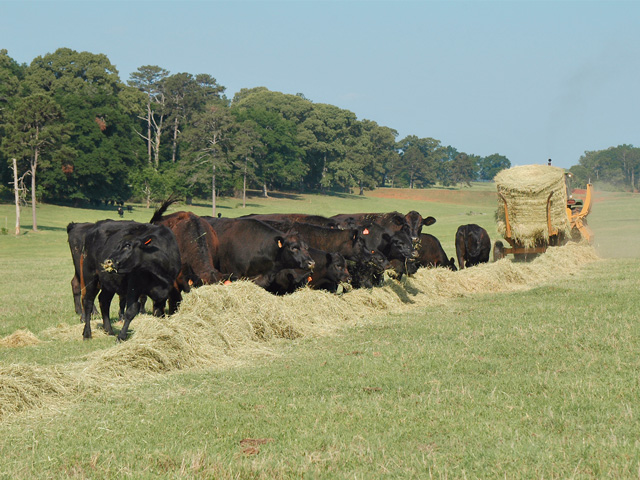FMD Outbreak in Namibia
NCBA Expresses Concern About Foot-and-Mouth Disease Outbreak in Africa
OMAHA (DTN) -- One major U.S. cattle group is keeping an eye on a foot-and-mouth disease outbreak among cattle in Namibia. The government there now has restricted the movement of hoofed animals from a region in the northeastern part of the country to contain the disease.
According to a report from the Namibian government, 13 head of cattle were confirmed to have foot-and-mouth disease out of a herd of 657 animals. The outbreak was reported on Sept. 25. The government said it confirmed the diseased cattle on Sept. 28 through a laboratory test. The outbreak occurred in a pen in the village of Kavango East, Namibia.
The 13 animals were isolated from the herd, according to the government report.
On Oct. 7, Africa's agriculture ministry announced the movement of all cloven-hoofed animals and their products had been banned after the outbreak. That includes auctions and cultural shows. In addition, all movement of animals across the Namibian/Angolan border was suspended. The ministry said it has sent teams of experts into the region for vaccination and monitoring.
In October 2006, USDA's Animal and Plant Health Inspection Service recognized the region of Namibia south of the veterinary cordon fence as free of FMD with special restrictions. Areas of Namibia north of the cordon fence is an established buffer zone and is not considered free of FMD. The current outbreak is located on the northeastern border of the buffer zone.
According to USDA, just one establishment in the infected region is approved to export fresh, chilled or frozen beef from Namibia to the United States. The establishment is in the FMD-free region south of the cordon fence, where special restrictions are in place.
That means a country or region considered to be free of a disease but borders an affected country imports live ruminants or swine from affected countries under conditions less restrictive than would be accepted for importation into the United States.
P[L1] D[0x0] M[300x250] OOP[F] ADUNIT[] T[]
Such regions also may supplement their national meat supplies by importing fresh meat of ruminants or swine from countries affected with FMD.
Meat exported from these countries must meet additional animal health requirements mitigating FMD concerns.
According to USDA's Food Safety and Inspection Service, the first shipment of fresh beef was received in October 2018, and from Jan. 1, 2020, through Oct. 1, 2020, the U.S. imported 1.1 million pounds of fresh beef from Namibia.
The shipment from February 2020 was the first large commercial shipment.
"Given this, and the length of time that Namibia has successfully maintained their free-FMD zone, and the fact that they have successfully and quickly addressed outbreaks in the buffer zone, APHIS does not recommend taking any action at this time to change the FMD recognition of Namibia," a USDA spokesperson said in a statement.
CATTLE GROUP CONCERNED
In a news release Wednesday, the National Cattlemen's Beef Association expressed concern about the report.
"Foot-and-mouth disease is a grave and persistent threat to the U.S cattle industry and warrants every available caution and protection to ensure that the problems plaguing cattle production in other parts of the world do not reach our shores," NCBA Vice President of Government Affairs Ethan Lane said in a statement.
"NCBA has serious concerns regarding the latest report of another FMD outbreak in Namibia, a country with an unfortunate history of FMD. While Namibia has taken steps to mitigate risk of FMD through the establishment of a cordon fence and buffer zone, the occurrence of this most recent outbreak in the buffer zone and indications of delayed reporting of the outbreak to the World Organization for Animal Health raises serious concerns about Namibia's newly granted access to the United States."
Lane said USDA should investigate the "efficacy" of Namibia's cordon fence, security of Namibia's buffer zone and surrounding FMD protocols.
Foot-and-mouth disease is a severe and highly contagious viral disease, causing illness in cows, pigs, sheep, goats, deer and other animals with divided hooves. It does not affect horses, dogs or cats, according to USDA.
FMD is not a public health or food safety threat. It is also not related to hand, foot and mouth disease, which is a common childhood illness caused by a different virus.
Namibia experienced one of the worst FMD outbreaks in history in 2015, taking nearly a year and $13 million to eradicate. It spread across three regions in Africa. Namibia was declared FMD-free in January 2016. The nation has a traceability system.
Todd Neeley can be reached at todd.neeley@dtn.com
Follow him on Twitter @toddneeleyDTN
(c) Copyright 2020 DTN, LLC. All rights reserved.




